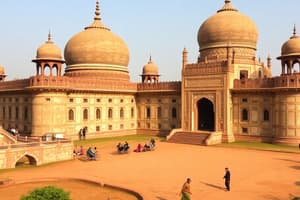Podcast
Questions and Answers
What was a key factor that contributed to the rise of the Han dynasty?
What was a key factor that contributed to the rise of the Han dynasty?
- Democratic governance
- Isolationist policies
- Religious fervor
- Technological advancements (correct)
How did Rome establish dominance in the Mediterranean region?
How did Rome establish dominance in the Mediterranean region?
- By avoiding interactions with other cultures
- Through economic alliances
- Through diplomatic isolation
- Through military victories and innovative governance (correct)
What differentiated Kublai Khan's approach to control from Genghis Khan's?
What differentiated Kublai Khan's approach to control from Genghis Khan's?
- Genghis Khan avoided expanding the empire
- Kublai Khan used diplomacy rather than warfare (correct)
- Kublai Khan only relied on military conquest
- Genghis Khan focused on conquering through trade
Which of the following was not a common element in the rise of historical empires as mentioned in the text?
Which of the following was not a common element in the rise of historical empires as mentioned in the text?
What notable achievement facilitated trade and communication among different civilizations during the Mongol Empire?
What notable achievement facilitated trade and communication among different civilizations during the Mongol Empire?
Which empire was known for its administrative structure based on religious tolerance and fair treatment of conquered populations?
Which empire was known for its administrative structure based on religious tolerance and fair treatment of conquered populations?
Who was the ruler associated with the expansion of the Macedonian Empire beyond Greece and into most of the known ancient world?
Who was the ruler associated with the expansion of the Macedonian Empire beyond Greece and into most of the known ancient world?
Which empire played a significant role in facilitating trade between East and West by uniting Greek city-states with Asian territories?
Which empire played a significant role in facilitating trade between East and West by uniting Greek city-states with Asian territories?
Which empire briefly united all Chinese states during China's Warring States Period before descending into chaos?
Which empire briefly united all Chinese states during China's Warring States Period before descending into chaos?
Which empire's ruler was known as 'the Great' and successfully expanded territory to include most of the known ancient world up until the Himalayas?
Which empire's ruler was known as 'the Great' and successfully expanded territory to include most of the known ancient world up until the Himalayas?
Flashcards are hidden until you start studying
Study Notes
Rise of Empires and Kingdoms through History
Throughout human history, societies have evolved from small communities into vast empires and powerful kingdoms, shaping our world's cultural and political landscape. While we cannot possibly cover each empire in detail here, I aim to introduce you to some significant rising powers and their impacts on global civilization.
Achaemenid Empire (6th Century BCE)
The first prominent example is Persian emperor Cyrus II the Great, who established the sprawling Achaemenid Empire stretching across modern Iran, Iraq, parts of Afghanistan, Pakistan, and several neighboring regions by 550 BC. This empire's administrative structure, built upon religious tolerance and fair treatment of conquered populations, set an early standard for ruling over diverse peoples.
Macedonian Empire (4th Century BCE)
Almost two centuries later, Alexander III 'the Great,' ruler of Macedonia, expanded his father Philip II's territory beyond Greece and eventually encompassed most of the known ancient world up until the Himalayas. By uniting Greek city-states with Asian territories under one rule, this short-lived empire contributed significantly to the spread of Hellenistic culture and facilitated trade between East and West.
Han Dynasty (3rd Century BCE – 2nd Century CE)
During China's Warring States Period, the Qin dynasty briefly united all Chinese states before succumbing to chaos after its founder's death. Subsequently, Liu Bang founded the Han dynasty, which ushered in more than four centuries of stability and prosperity. This period saw technological advancements, artistic achievements, increased agricultural productivity, improved transportation infrastructure, and expansive diplomatic ties — laying foundations for subsequent eras like the Silk Road.
The Roman Republic & Roman Empire (8th Century BCE - 5th Century CE)
Roman civilization began as republican city-states on the Italian peninsula coalescing into a single state around 27 BC. Rome rose to become the dominant power in the Mediterranean region due to strategic military victories, innovative governance, as well as absorbing other cultures into its own. As it grew, so too did its influence span Western Europe and North Africa.
Mongol Empire (13th Century)
Genghis Khan, founder of the Mongol Empire, brought unprecedented levels of conquest and integration of disparate tribes and ethnic groups under one umbrella. His son Ögedei continued this expansionist policy, while Kublai Khan consolidated control across much of Asia through diplomacy rather than warfare. Through their interconnected road system, they fostered trade and communication among different civilizations.
These examples represent just a fraction of the myriad empires throughout historical timeframes. Each rose to prominence using various means, often combining elements such as strong leadership, effective administration, technological advantages, adaptability, and sheer luck. Their stories continue to inspire, teach, and serve as cautionary tales for present and future generations alike.
Studying That Suits You
Use AI to generate personalized quizzes and flashcards to suit your learning preferences.




